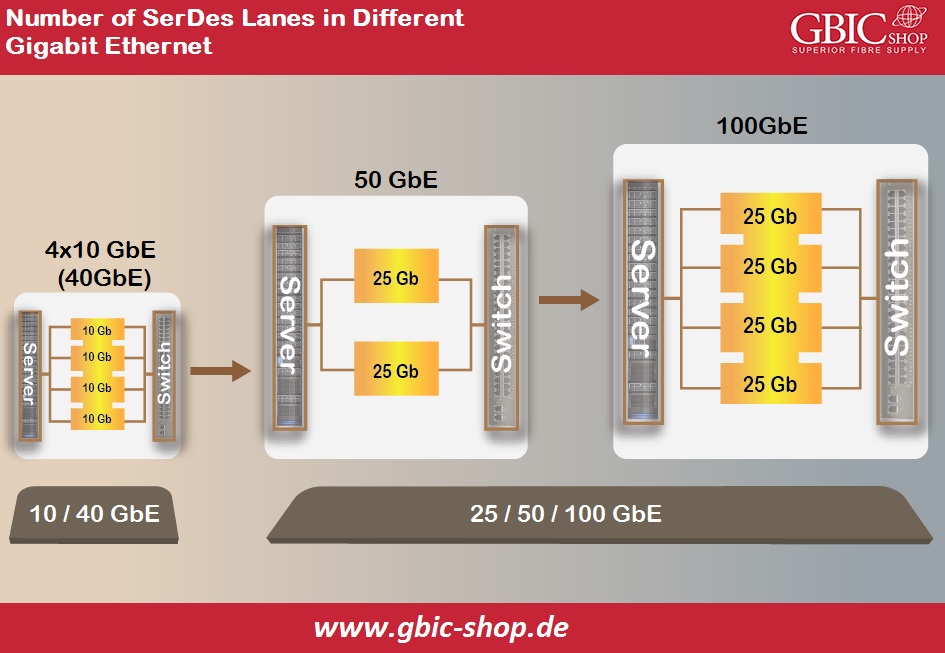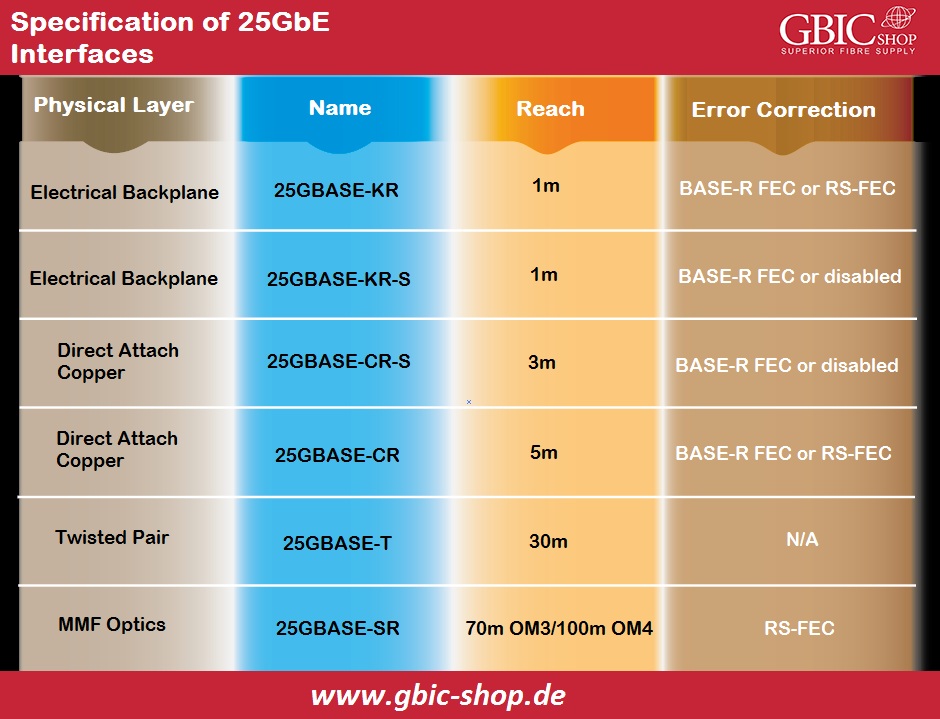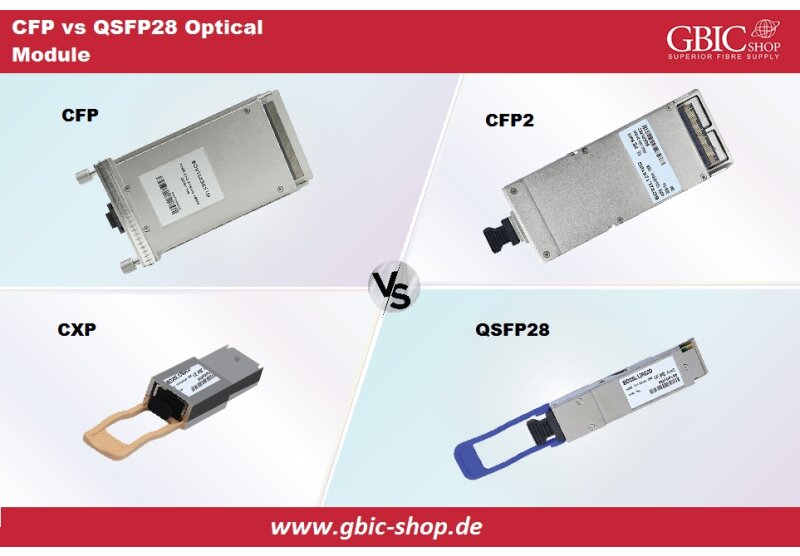Ethernet industry and networking are working in another direction, and it is 25 Gigabit Ethernet with the increasing demand in a cloud database for bandwidth. If we compare the advanced ways of 10G Ethernet-25G Ethernet-100G Ethernet and 10G Ethernet-40G Ethernet-100G Ethernet, we will see that 25G Ethernet seems more refined and popular by customers. Why should we select 25GbE? How can we interpret the strong points of 25GbE? This writing will give an outlook of 25GbE from all sides.
EVOLUTION OF 25GbE:
Previously, the network engineers were surprised at the concept of a 10GbE connection. But, cloud computing and virtualization generated modern challenges of networking demanding additional bandwidth. Usually, the most significant TOR switches in data centers develop 10GbE very quickly. Moreover, to compete with the requirements, the IEEE approved a 100GbE and 40GbE standard, however for cloud providers, 10GbE is not low-cost or effective in TOR switching, and the implementation of 100GbE is comparatively expensive and complex. 25GbE standard was created in opposition to such a situation by IEEE 802.3, utilized for the connectivity of Ethernet that will provide benefit to enterprise and cloud database conditions. The foundation of 25G Ethernet is on IEEE 100G Ethernet, and it utilizes one lane 25Gbps connections of Ethernet via 4x25 Gigabit per second lanes.
25G ETHERNET CABLES AND OPTICS:
Two major form factors QSFP28 and SFP28, are supported by the physical interface standard of 25G Ethernet. Generally used optical transceivers are 25G Ethernet SFP28.
The 25G Ethernet PMDS identify low price TWINAXIAL copper wires for the function of 25Gbps demanding only two pairs of twin axial wires. Servers can be connected to TOR switches by the connections founded on copper TWINAXIAL wires and work for inter-rack links between routers and switches. Fan-out cables can connect to speeds of 10/25/40/50 Gigabit per second and can right now be achieved on copper cables, SMF and MMF, keeping up with the range to the particular implementation requirements. Generally utilized cables are 25G Ethernet AOC and 25G Ethernet DAC.
WHY SELECT 25G ETHERNET?
When for most of the existing implementations, 10GbE is good, it does not effectively deliver the required bandwidth. Nevertheless, it needs other devices, remarkably increasing costs. Moreover, 40G Ethernet is power efficient and beneficial for cloud providers in TOR switching. So, 25G Ethernet was created for progress and to get out of the difficulty.
SOME SERIALIZER//DESERIALIZER LANES:
SERIALIZER/DESERIALIZER (SERDES) is a combined transceiver or circuit utilized in high-level speed transmissions for transforming serial data to aligned interfaces and likewise. The transponder part is a series to a parallel transformer, and the adopter part is equal to the series converter. Presently, 25Gbps is the rate of SERIALIZER/DESERIALIZER. We can say that at 25Gbps, we require only a single SERDES lane to link one ending point of the 25G Ethernet card to the further ending point of the 25G Ethernet card. Contrarily, four 10G Ethernet SERIALIZER/DESERIALIZER lanes are required by 40G Ethernet to attain links. Consequently, we need four pairs of optical fibers for connections between two network cards of 40G Ethernet. Moreover, 25GbE presents a simple advanced way to 50 Gigabit and 100 Gigabit network.

FOR PCI EXPRESS LANES, 25G ETHERNET NIC IS MORE EFFECTIVE:
Popular Intel Xeon CPU presents 40 lanes of PCI Express 3.0 with one lane bandwidth of around 8Gbps. We use the lanes called PCI Express for connections between NIC and CPU. Moreover, we also use these lanes for connections between GPU cards, RAID cards, and all remaining peripheral cards. That's why it is essential to extend the usage of confined PCI Express lanes by NIC. One 40G Ethernet requires not less than a single PCI Express 3.0x8 lane. Therefore, if two ports of 40G Ethernet can work with perfect speeds simultaneously, the usage of actual lane bandwidth is 40 Gigabit* 2/(8 Gigabit*16)=62.5%. Contrarily, 25G Ethernet NIC card requires single PCI Express 3.0x8 lanes, and the usage effectiveness is 25 Gigabit* 2/(8 Gigabit*8)=78%. 25G Ethernet is considerably more flexible and effective than 40G Ethernet regarding PCI Express lanes.
COST-EFFECTIVE CABLING OF 25G ETHERNET:
40G Ethernet switches and cards use QSFP+ modules with comparatively expensive MPO/MTP wires not adaptable to LC fiber optics of 10G Ethernet. In case of enhancement to 40G Ethernet founded on 10G Ethernet, many optical fiber wires will be discarded and renewed, which will be very costly. Contrarily, 25G Ethernet switches and cards use SFP28 optical transceivers and are adaptable to LC fiber optics of 10G Ethernet because of a one-lane link. We can evade the renewal of wires in case of enhancement from 10G Ethernet to 25G Ethernet, which proves to be economical and time-saving.
DIFFERENT ADVANTAGES OF 25G ETHERNET FOR SWITCH INPUT/OUTPUT:
At first, 25G Ethernet has the most significant switch INPUT/OUTPUT presentation and fabric capacity. Network bandwidth presentation of 10G Ethernet can be enjoyed 2.5 times by the cloud companies and web-scale. Transferred across one lane, 25G Ethernet also puts forward network expandability and a higher density of switch ports. In the second place, 25G Ethernet can decrease operating and capital expenses by considerably reducing the desired number of cables and switches accompanied by facility expenses related to power, cooling, and space compared to the technology of 40G Ethernet. Lastly, 25G Ethernet making use of one lane 25 Gigabit per second Ethernet connection protocol leverages the current standard of IEEE 100G Ethernet, which we deploy as four lanes of 25Gbps working on four copper or fiber pairs.
PREDICTION FOR 25GbE FUTURE MARKET:
In the past, 25GbE has gained a lot of popularity, and the products of 25G Ethernet have experienced considerable progress and got an expanding market share. In 2020, 25G Ethernet was supposed to find a broader market and continue flourishing in upcoming years. 25G Ethernet is reliable in networks of data centers having high-speed as an adapter of 25G Ethernet can also work at 10G Ethernet speeds. Moreover, 25G Ethernet switches provide a more appropriate way to move to 100 Gigabit or 400 Gigabit networks by getting around the 40G Ethernet upgrade. At the same time, we cannot miscalculate the requirement for industry concord building. Currently, we primarily utilize 25G Ethernet for the implementation switch-to-server. 25GbE can become advanced in case of switch-to-switch implementations are promoted on a large scale. In short, the movement towards 25G Ethernet is progressive.
CONCLUSION:
Regardless of market research, 25GbE inevitably looks to be the desired option because it is cost-effective, offers high bandwidth, and needs low power consumption. Considering the practical advantages of 25GbE, we can predict to proceed with 25GbE in the upcoming days.
 English
English
 Deutsch
Deutsch
 Espaniol
Espaniol











